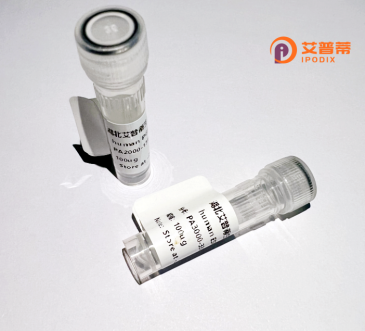
| 纯度 | >90%SDS-PAGE. |
| 种属 | Human |
| 靶点 | NME1-NME2 |
| Uniprot No | P15531 |
| 内毒素 | < 0.01EU/μg |
| 表达宿主 | E.coli |
| 表达区间 | 2-152 aa |
| 活性数据 | ANCERTFIAIKPDGVQRGLVGEIIKRFEQKGFRLVGLKFMQASEDLLKEHYVDLKDRPFFAGLVKYMHSGPVVAMVWEGLNVVKTGRVMLGETNPADSKPGTIRGDFCIQVGRNIIHGSDSVESAEKEIGLWFHPEELVDYTSCAQNWIYE |
| 分子量 | 44 kDa |
| 蛋白标签 | His tag N-Terminus |
| 缓冲液 | 0 |
| 稳定性 & 储存条件 | Lyophilized protein should be stored at ≤ -20°C, stable for one year after receipt. Reconstituted protein solution can be stored at 2-8°C for 2-7 days. Aliquots of reconstituted samples are stable at ≤ -20°C for 3 months. |
| 复溶 | Always centrifuge tubes before opening.Do not mix by vortex or pipetting. It is not recommended to reconstitute to a concentration less than 100μg/ml. Dissolve the lyophilized protein in distilled water. Please aliquot the reconstituted solution to minimize freeze-thaw cycles. |
以下是关于重组人NME1-NME2蛋白的参考文献概要:
---
1. **文献名称**:*"Structural and functional characterization of the human Nm23-H1/H2 heterodimer"*
**作者**:Lacombe ML, et al.
**摘要**:该研究通过X射线晶体学解析了重组人NME1-NME2异源二聚体的三维结构,揭示了其核苷二磷酸激酶(NDPK)活性位点的构象变化,并探讨其在肿瘤转移抑制中的潜在机制。
---
2. **文献名称**:*"Biochemical properties of the Nm23-H2/Nm23-H1 heterodimer: implications for its role in tumor progression"*
**作者**:Steeg PS, et al.
**摘要**:通过重组表达纯化NME1-NME2蛋白,研究发现该异源二聚体比同源寡聚体具有更高的NDPK酶活性,可能通过调控细胞内核苷酸稳态影响癌细胞迁移和侵袭能力。
---
3. **文献名称**:*"Functional interaction between NME1 and NME2 proteins in DNA repair processes"*
**作者**:Ma D, et al.
**摘要**:本文利用重组NME1-NME2复合物证明两者协同参与DNA损伤修复通路,其功能依赖异源二聚体与DNA-PK激酶的相互作用,提示其在基因组稳定性中的新角色。
---
4. **文献名称**:*"Distinct roles of NME1 and NME2 in extracellular vesicle-mediated metastasis suppression"*
**作者**:Krishnan KS, et al.
**摘要**:通过重组蛋白实验,发现NME1-NME2异源二聚体通过调控外泌体的蛋白质组成抑制肿瘤转移,而单一亚基无法重现此效应,强调了复合物的独特功能。
---
以上研究均聚焦于重组NME1-NME2的生化特性、结构及功能,涵盖其在肿瘤生物学和细胞信号通路中的多效性。
The NME1-NME2 protein complex, also known as nucleoside diphosphate kinase (NDPK) heterohexamer, comprises two homologous subunits (NME1 and NME2) encoded by the NME1 and NME2 genes located on human chromosome 17q21.3. These evolutionarily conserved proteins belong to the NME/NM23 family, initially identified for their nucleoside diphosphate kinase activity, which facilitates phosphate transfer between nucleoside triphosphates and diphosphates, maintaining cellular nucleotide pools critical for DNA/RNA synthesis and energy metabolism. Beyond this housekeeping role, NME1-NME2 gained prominence for its metastasis-suppressor function, particularly in cancers, where reduced expression correlates with increased metastatic potential.
Structurally, the functional unit is a hexamer formed by alternating NME1 and NME2 subunits. Both isoforms share ∼88% sequence identity but exhibit functional divergence: NME1 is more strongly associated with tumor suppression, while NME2 shows distinct roles in transcriptional regulation and cilia function. Recombinant NME1-NME2 proteins are typically produced in bacterial (e.g., E. coli) or eukaryotic expression systems, enabling studies of their enzymatic kinetics, interactions (e.g., with histidine kinase KSR1 or Ras-related proteins), and structure-guided drug discovery. Current research focuses on leveraging this complex as a therapeutic target, exploring its roles in exosome biology, autophagy, and cytoskeletal dynamics. However, mechanistic details of its metastasis-suppressive action, particularly non-enzymatic functions, remain active areas of investigation.
×